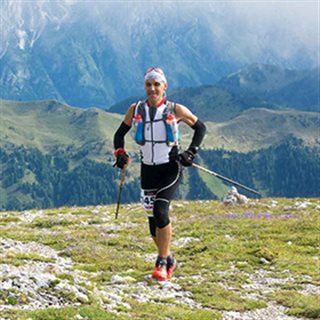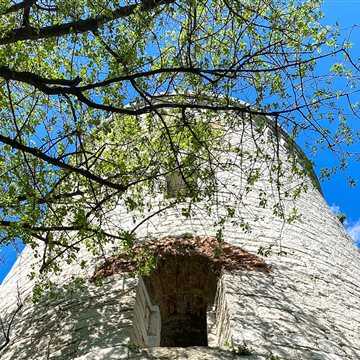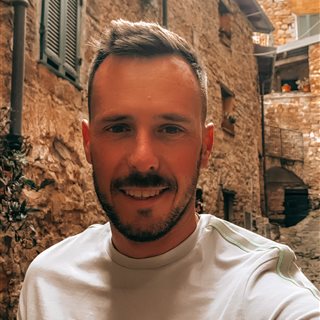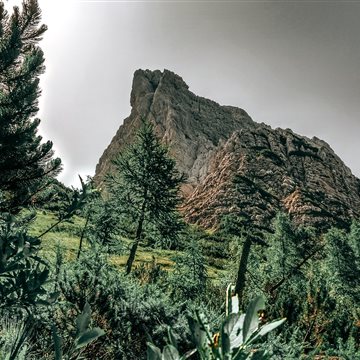



Although I have always lived in Aquileia, I have only recently discovered that there has been a route called the Cammino Celeste (Celestial Way) or Iter Aquileiense for the past ten years, which passes through here to the Sanctuary of Castelmonte to the Sanctuary on Monte Lussari. I do a little work and find the book written by the person who planned and then walked it. Here are a few phrases from it: “The Celestial Way is a pilgrimage created on the initiative of a group of people belonging to the Circolo Culturale Navarca at Aiello del Friuli, united by the fact of being pilgrims”… “Saint Mark the evangelist came from the sea declares the legend and it is by the sea that the path begins”. Each stage is a vertebra. Following the path is like building a small spinal column of Friuli Venezia Giulia”. (“Il Cammino Celeste” published by Ediciclo).
The words heard later by one of the creators of the walk during a meeting that celebrates a decade since its creation, “It is not important how you intend to do the Celestial Way, whether as pilgrims or as lay people, for yourself or for others or for any other reason: the important thing is to do it, it will change your life”. In me, a person who is always looking for adventure, sport and travel in nature, it sparked a desire and the curiosity to tackle it... to try this new experience. So I begin to learn more and prepare for the Way, while waiting for the summer. I read that many start from the island of Barbana, where there is the Shrine of the Blessed Virgin, reaching the mainland by boat and then walking on foot along the various stages.
The route is marked by a stylised fish, there are various stopping points and the journey takes about ten days, taking the pilgrim to some of the unique and wonderful places of Friuli Venezia Giulia. Unfortunately, I only had little time available, so I had to find a different way to do it, something that would shorten the travel time but also stimulate my adventurous and sporty soul.
The first question: how to reach the land safely from the island of Barbana but in sportin fashion? Swimming in the lagoon was maybe not the best option in view of my preparation, so I was left with the option of a rowing boat or something like that. Talking with a group of friends someone mentioned a kayak and so I turned to these people who practise this sport to help me out for the first stage. Question 2: How to speed up the rest of the way? Here things were a little simpler and I opted for a mountain bike as the track goes through country roads and tracks as well along paved stretches. But not all the way can be done by bike and the last part would be reserved for my legs alone.
I found information from both the website and the blog of the Celestial Way, read the experiences written by those who have already done it and downloaded the GPS track of the path to my smartphone. I studied the territory on specific maps, planned the days and the stages manage to find three days that I will divide in two periods: the first of two days between kayaking, biking and walking; the second entirely on foot. So everything is ready and the excitement before departure rises...!
The alarm sounds at dawn, I prepare myself and meet my friends of the CKF amateur sports team team at Belvedere to take the kayak to Barbana Island. A few photos and off we go on our adventure. Canoeing early in the morning in the lagoon is an experience I had never enjoyed and it the contact with nature as it awakes is really exciting, and it offers unique views in a relaxing silence. I know that I will add kayaking as a sport to practise. In a short time we return to the beach we began from just opposite the island. Disembarked and changed, I pedal along the Alpe Adria bike trail to the Basilica of Aquileia where I take ten minutes to relax. I sit next to the Basilica sipping a good coffee and eating the Celestial Way biscuits. Everything is great, and I hope this little rite also serves as a lucky omen.
With a small backpack and my helmet strapped on well I start again, soon to reach Aiello del Friuli where there are the countless sundials that make a beautiful display on the houses; I do not know why but my attention is drawn to a depiction of the sign of Sagittarius. Continuing, I come to Medea and climb the hill where in 1951 a monument was erected, the Ara Pacis Mundi to remember the dead of all wars. I then head for Cormons and so enter the Collio area which makes ??excellent wines. Here the plain gives way to hills. Woods, dirt tracks and comfortable paths lead me up and down hills to Castelmonte where by chance I am welcomed by the sound of the bells of the Shrine that has been a place of devotion to the statue of Our Lady since 1175.
I eat something and take on water and it is time to go down to Cividale del Friuli founded by the Romans in the first century BC, cross the Devil’s Bridge over the Natisone River and pass through the city full of history, walking with my bike by my side. History and houses give way to meadows, woods and roads and then to footpaths that begin to climb more and more steeply where it is not always easy to ride and sometimes I have to push my travel companion. Now we are alone with it and the nature around us, a nature that here is untouched... beautiful!!! The sun is going down, so I switch on the lights on the bike and helmet, and a new world appears: darkness, silence, nature and solitude. Time goes by but the day is not over yet and it starts to rain a little. Far ahead, I see some lights: maybe a house? When planning the route I hadn’t noted this building near the village of Canebola in the municipality of Faedis.
But the house is not a home but a farmhouse; it’s late but there’s still somebody inside. I rest the bike on the wall and step inside, exchanging a few words with the manager to find about the conditions of the route as I don’t know much about this area. Hearing words about landslides and bears, I am very happy to accept her hospitality. Spending the night hours there and resting a few hours while waiting for the dawn in the warm and dry agriturismo was certainly a good idea. I fall deeply asleep and only seconds seem to pass before the alarm goes off at the start of dawn as I prepare for the last stretch of this stage. The bike is there waiting for me. I pedal on asphalt but soon leave this and have to push the bike to pass the landslide, before arriving at Prossenicco, but everyone is still asleep here. I follow a torrent, and dive into a magnificent landscape. Some more pedalling and I reach Montemaggiore, a small village on the slopes of the mountain bearing the same name that is part of the massif of the Julian foothills called Gran Monte. Here there is a bar open where I drink a well-deserved and good coffee.
I change and leave the bike in this village after 105 kilometres. When I leave the village I take a path that starts at an altitude of 790 metres and takes me all the way up to 1600, before descending through the woods to Passo Tanamea where the Rio Bianco flows through a beautiful and deep canyon, where I can fill my bottles with fresh water and eat a bite on its boulders just under the high arches of the road that passes overhead. I start climbing again to a casera, an unmanaged mountain shelter, pass another mountainous summit and descend to the Carnizza saddle and pass the picturesque and unexpectedly lively Stavoli Gnivizza. Time is passing and it has been fun up here but I must quickly reach Prato di Resia where they are waiting for me to go back to the bike and take me home. But if in some cases I have been inspired by the course of the Celestial Way but taken a few diversions, I now prefer to follow the way closely. I ride the convenient asphalt road that descends in curves quickly down to the village. This is the of my first stage, and finish with about 140 kilometers from the start under my belt in a period of 36 hours and with endless emotions.
At home, while waiting to continue the trip, I rearrange my ideas and mentally trace the path I've done to improve the preparation of the last stage, but I am already thinking how to make the first stretch possible on a bicycle for a future re-run. I tell some friends about this new experience and convince three of them to come with me to finish the Iter Aquileiense from Prato di Resia to Monte Lussari.
Finally comes the day of the second stage and I start this time in company. We reach the beautiful Val Resia early, get ready, take some photos and set off. The starting point is the Visit Centre of Resia of the Julian Foothills Nature Park. After a few metres of asphalt road we immediately turn off onto a path. It leads comfortably through the woods and then comes to the little chapel of Sant’Antonio marking the high point of this first stretch. Fortunately, it is a beautiful sunny day and the heat begins to warm us so we collect some fresh water at a nearby fountain, and then begin to drop down through a charming scene alongside a torrent. After a short time, the forest opens up and at the bottom of the valley we see the village of Chiusaforte.
We arrive at the centre of the village and wasl through as far as the Alpe Adria cycle trail, built on the old railway line. The uphill slope is thus quite easy and we quickly reach Dogna. It’s only a few kilometres but includes several evocative views. We pass through the tunnels through which trains used to run until a few years ago and cross over a magnificent iron bridge and by a cascade visible only by bicycle. We pass the deserted train station of Dogna and shortly afterwards turn left to take the road that enters Val Dogna and rises to an Alpine hut near the Sella di Sompdogna. We follow the asphalt road, pass several villages – Roncheschin, Chiut, Mincigos – small hamlets that reveals numerous testimonies of the First World War. These include the Rio Mas bridge, the remains of Chiut’s howitzer emplacement and monumental cable car, amd the fortified trenches of the Plans area. The road itself at different points is a testimony of that period. From the road we move to a path that leads to the “little lake” which is such now only in name.
From here we quickly reach the mountain hut, sitting outside with a view of our next destination, Monte Lussari; we can now eat and drink something and relax. The bell on the mountains chimes and reminds us that break is over, and a quick and cheerful descent brings us to the beautiful Val Saisera. Following the Saisera stream we arrive at the Oitzinger Meadows from where we take the unpaved road that climbs, giving us a wonderful view of the Val Saisera below. Walking in company, one does not notice tired limbs and the miles that pass and while it takes us a few hours it actually seems that we reach the picturesque village, the shrine and the summit of the Lussari very quickly. From here we have a wonderful all-round view over the valley of Tarvisio, the village of Camporosso beneath and the surrounding hills, the Mangart and Jof di Montasio massifs. We are at the most eastern point of the Alps, a point of encounter and border between three peoples, Latin, Germanic and Slavic, whose people climb here on pilgrimage to worship the statuette of the Madonna and Child inside the Sanctuary. An ancient tradition has its construction dating back to 1360 AD, erected after a series of miraculous eventd concerning the finding of the statuette. Usually the Sanctuary is reached by walking the impressive Pilgrim’s Trail that runs through the forest of the Tarvisio, and we use this to get down to the valley. In fact, we are the only ones to follow it in that direction down to the monument of the Celestial Way, the fourth in order after that of the Sanctuary of Barbana, Castelmonte and Monte Lussari.
Walking is one of the best ways to travel, allowing you to enjoy the world around you to the full, giving you unique glimpses and details that only this kind of progress can give offer. Only the slow passage of time and space allows you to relax, to let your thoughts wander and to see what is really around you, things whose existence you cannot even imagine from a car window.
The Celestial Way has been a wonderful journey: I travelled from the sea to the mountains of Friuli Venezia Giulia, totalling about 180 km and 7000 metres in height difference, first alone, then in company, always immersed in magnificent, unique landscapes that will always be imprinted in my mind and in my heart; I already feel nostalgia for them.
So on to the next path!




 Andrej Bandelj
Andrej Bandelj
